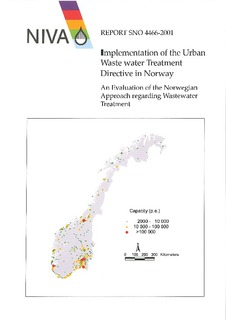| dc.contributor.author | Källqvist, T. | nb_NO |
| dc.contributor.author | Molvær, J. | nb_NO |
| dc.contributor.author | Oug, E. | nb_NO |
| dc.contributor.author | Berge, D. | nb_NO |
| dc.contributor.author | Tjomsland, T. | nb_NO |
| dc.contributor.author | Stene-Johansen, S. | nb_NO |
| dc.contributor.other | Källqvist, T. - Project manager | nb_NO |
| dc.coverage.spatial | Norge | nb_NO |
| dc.date.accessioned | 2014-08-01T10:46:49Z | |
| dc.date.available | 2014-08-01T10:46:49Z | |
| dc.date.issued | 2002 | nb_NO |
| dc.identifier | 4466 | nb_NO |
| dc.identifier.isbn | 82-577-4113-2 | nb_NO |
| dc.identifier.issn | 1894-7948 | nb_NO |
| dc.identifier.uri | http://hdl.handle.net/11250/211520 | |
| dc.description | Årsliste 2002 | nb_NO |
| dc.description.abstract | This report discusses the effects and benefits of full implementation of the Urban Waste Water Treatment Directive in Norway. The Norwegian policy for wastewater treatment has targeted phosphorus removal as the primary measure to reduce adverse effects of discharge of wastewater to freshwater and marine recipients. Chemical precipitation is therefore used at more than 70% of the wastewater treatment plants. This technique is very efficient in reducing the phosphorus concentration and in addition gives a high reduction of suspended solids, micropollutants and bacteria. The removal of organic matter is, however, not always sufficient to fulfil the requirements in the Directive. The high amount of available fresh water, and the high sensitivity of fresh water systems to incresed phosphorus loading implies that the primary load of organic matter from wastewater is less important than the organic matter produced in the surface waters on the basis of nutrients from the wastewater (secondary organic load). For wastewater dicharged to marine waters the situation is more diverse due to the large variation in receiving water conditions. The most sensitive marine recipients are the fjords with restricted exchange of deep water. Like in lakes, the secondary organic load caused by primary production may contribute far more than the primary load to the oxygen depletion of the deep water. Therefore nutrient removal is required as the primary measure also for wastewater discharged to marine waters. | nb_NO |
| dc.description.sponsorship | Statens forurensningstilsyn (SFT) | nb_NO |
| dc.publisher | Norsk institutt for vannforskning | nb_NO |
| dc.relation.ispartofseries | NIVA-rapport;4466 | nb_NO |
| dc.rights | Navngivelse-IkkeKommersiell-DelPåSammeVilkår 3.0 Norge | nb_NO |
| dc.rights.uri | http://creativecommons.org/licenses/by-nc-sa/3.0/no/ | nb_NO |
| dc.subject | økotoksikologi og risikovurderinger | nb_NO |
| dc.title | Implementation of the Urban Waste Water Treatment Directive in Norway - An Evaluation of the Norwegian Approach regarding Wastewater Treatment | nb_NO |
| dc.type | Research report | nb_NO |
| dc.rights.holder | Norsk institutt for vannforskning/Norwegian institute for water research | nb_NO |
| dc.subject.nsi | VDP::Matematikk og naturvitenskap: 400 | nb_NO |
| dc.source.pagenumber | 70 | nb_NO |
| dc.subject.keyword | kommunalt avløpsvann | nb_NO |
| dc.subject.keyword | renseanlegg | nb_NO |
| dc.subject.keyword | organisk stoff | nb_NO |
| dc.subject.keyword | næringssalter | nb_NO |
| dc.subject.keyword | wastewater treatment | nb_NO |
| dc.subject.keyword | organic matter | nb_NO |
| dc.subject.keyword | urban | nb_NO |
| dc.subject.keyword | plants | nb_NO |
| dc.subject.keyword | nutrients | nb_NO |
| dc.relation.project | O-21195 | nb_NO |


